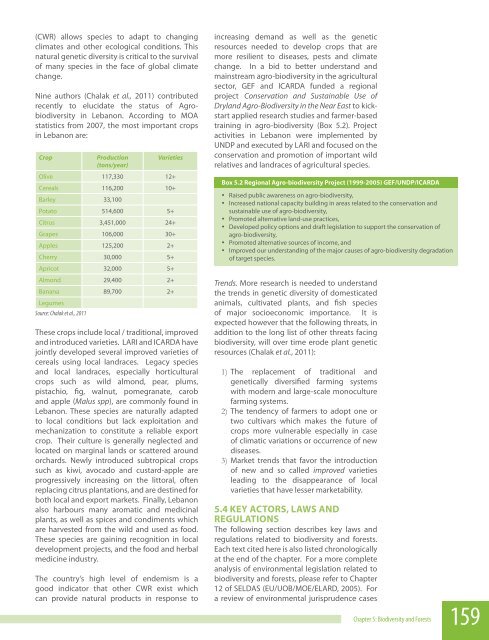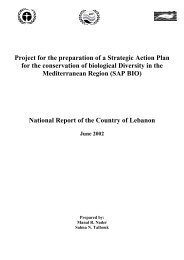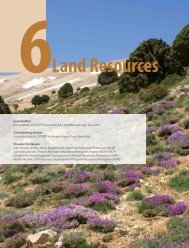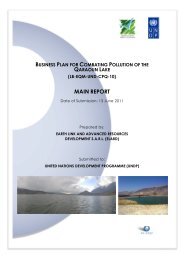Biodiversity and Forests
Biodiversity and Forests
Biodiversity and Forests
You also want an ePaper? Increase the reach of your titles
YUMPU automatically turns print PDFs into web optimized ePapers that Google loves.
(CWR) allows species to adapt to changing<br />
climates <strong>and</strong> other ecological conditions. This<br />
natural genetic diversity is critical to the survival<br />
of many species in the face of global climate<br />
change.<br />
Nine authors (Chalak et al., 2011) contributed<br />
recently to elucidate the status of Agrobiodiversity<br />
in Lebanon. According to MOA<br />
statistics from 2007, the most important crops<br />
in Lebanon are:<br />
Crop Production<br />
(tons/year)<br />
Varieties<br />
Olive 117,330 12+<br />
Cereals 116,200 10+<br />
Barley 33,100<br />
Potato 514,600 5+<br />
Citrus 3,451,000 24+<br />
Grapes 106,000 30+<br />
Apples 125,200 2+<br />
Cherry 30,000 5+<br />
Apricot 32,000 5+<br />
Almond 29,400 2+<br />
Banana<br />
Legumes<br />
Source: Chalak et al., 2011<br />
89,700 2+<br />
These crops include local / traditional, improved<br />
<strong>and</strong> introduced varieties. LARI <strong>and</strong> ICARDA have<br />
jointly developed several improved varieties of<br />
cereals using local l<strong>and</strong>races. Legacy species<br />
<strong>and</strong> local l<strong>and</strong>races, especially horticultural<br />
crops such as wild almond, pear, plums,<br />
pistachio, fig, walnut, pomegranate, carob<br />
<strong>and</strong> apple (Malus spp), are commonly found in<br />
Lebanon. These species are naturally adapted<br />
to local conditions but lack exploitation <strong>and</strong><br />
mechanization to constitute a reliable export<br />
crop. Their culture is generally neglected <strong>and</strong><br />
located on marginal l<strong>and</strong>s or scattered around<br />
orchards. Newly introduced subtropical crops<br />
such as kiwi, avocado <strong>and</strong> custard-apple are<br />
progressively increasing on the littoral, often<br />
replacing citrus plantations, <strong>and</strong> are destined for<br />
both local <strong>and</strong> export markets. Finally, Lebanon<br />
also harbours many aromatic <strong>and</strong> medicinal<br />
plants, as well as spices <strong>and</strong> condiments which<br />
are harvested from the wild <strong>and</strong> used as food.<br />
These species are gaining recognition in local<br />
development projects, <strong>and</strong> the food <strong>and</strong> herbal<br />
medicine industry.<br />
The country’s high level of endemism is a<br />
good indicator that other CWR exist which<br />
can provide natural products in response to<br />
increasing dem<strong>and</strong> as well as the genetic<br />
resources needed to develop crops that are<br />
more resilient to diseases, pests <strong>and</strong> climate<br />
change. In a bid to better underst<strong>and</strong> <strong>and</strong><br />
mainstream agro-biodiversity in the agricultural<br />
sector, GEF <strong>and</strong> ICARDA funded a regional<br />
project Conservation <strong>and</strong> Sustainable Use of<br />
Dryl<strong>and</strong> Agro-<strong>Biodiversity</strong> in the Near East to kickstart<br />
applied research studies <strong>and</strong> farmer-based<br />
training in agro-biodiversity (Box 5.2). Project<br />
activities in Lebanon were implemented by<br />
UNDP <strong>and</strong> executed by LARI <strong>and</strong> focused on the<br />
conservation <strong>and</strong> promotion of important wild<br />
relatives <strong>and</strong> l<strong>and</strong>races of agricultural species.<br />
Box 5.2 Regional Agro-biodiversity Project (1999-2005) GEF/UNDP/ICARDA<br />
• Raised public awareness on agro-biodiversity,<br />
• Increased national capacity building in areas related to the conservation <strong>and</strong><br />
sustainable use of agro-biodiversity,<br />
• Promoted alternative l<strong>and</strong>-use practices,<br />
• Developed policy options <strong>and</strong> draft legislation to support the conservation of<br />
agro-biodiversity,<br />
• Promoted alternative sources of income, <strong>and</strong><br />
• Improved our underst<strong>and</strong>ing of the major causes of agro-biodiversity degradation<br />
of target species.<br />
Trends. More research is needed to underst<strong>and</strong><br />
the trends in genetic diversity of domesticated<br />
animals, cultivated plants, <strong>and</strong> fish species<br />
of major socioeconomic importance. It is<br />
expected however that the following threats, in<br />
addition to the long list of other threats facing<br />
biodiversity, will over time erode plant genetic<br />
resources (Chalak et al., 2011):<br />
1) The replacement of traditional <strong>and</strong><br />
genetically diversified farming systems<br />
with modern <strong>and</strong> large-scale monoculture<br />
farming systems.<br />
2) The tendency of farmers to adopt one or<br />
two cultivars which makes the future of<br />
crops more vulnerable especially in case<br />
of climatic variations or occurrence of new<br />
diseases.<br />
3) Market trends that favor the introduction<br />
of new <strong>and</strong> so called improved varieties<br />
leading to the disappearance of local<br />
varieties that have lesser marketability.<br />
5.4 KEY ACTORS, LAWS AND<br />
REGULATIONS<br />
The following section describes key laws <strong>and</strong><br />
regulations related to biodiversity <strong>and</strong> forests.<br />
Each text cited here is also listed chronologically<br />
at the end of the chapter. For a more complete<br />
analysis of environmental legislation related to<br />
biodiversity <strong>and</strong> forests, please refer to Chapter<br />
12 of SELDAS (EU/UOB/MOE/ELARD, 2005). For<br />
a review of environmental jurisprudence cases<br />
Chapter 5: <strong>Biodiversity</strong> <strong>and</strong> <strong>Forests</strong> 159





